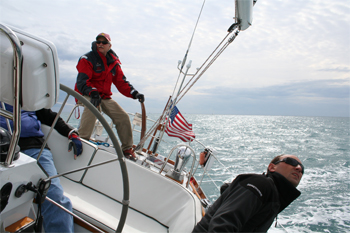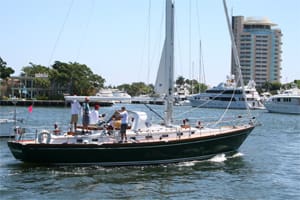To the editor: After spending enough time at sea, I believe a sailor develops an inner guiding voice that helps to keep him safe. Just such an event occurred on a recent running of the Fort Lauderdale to Key West Race. That guiding voice, along with some quick thinking, helped us avoid disaster.
When I came on deck at 0400 to take my turn at the helm, Jasmine, a Little Harbor 54 owned by John Evans, was blasting along the Florida Keys at 10 to 12 knots on a broad reach under full main and a huge spinnaker. We had overhauled several boats in our fleet and were now aiming on the stern lights ahead of us. What alarmed me was the fact that the lads had us running along in only 20 feet of water…much too close to nearby reefs for my comfort. While their reasoning that there was less adverse Gulf Stream current in the shallower water was correct, I knew that we had to work off into deeper water to give us enough sea room for me to feel at ease.
As I took the helm, I gradually moved us a little farther offshore into about 60 feet of water to calm the inner pilot. It was blowing NNE in the low 20 knots range with a quartering sea, providing a spirited workout on the helm to keep Jasmine on course.
 |
|
Andrea Dowling |
|
Ron Schaper mans the emergency tiller aboard Jasmine. |
There were 55 boats competing in this 35th (2010) running of the race. Rambler, a Reichel-Pugh 90, the big boy in the fleet, would complete the 160-mile course in 12.5 hours, while most of us mere mortals would run it in around 24 hours.
Given our current position and speed at 0400, Jasmine had a good chance of placing in our class. Indeed, Jasmine proved herself more than just a pretty boat when she placed first in last year’s Fort Lauderdale to Charleston Race.
As the breeze came on a little stronger and the quartering sea lifted the stern, I had to apply a little extra correction of the helm to port to swing Jasmine’s head back down. Just then… BANG! …the wheel spun freely as I nearly fell off my feet. “All hands on deck! We’ve lost steering!” I shouted.
Without the pressure of the rudder, the full sails immediately swung Jasmine up into the wind, sailing at over 10 knots right toward the reef. I scampered aft, opened the lazarette and removed the emergency steering tiller from its mount on the underside of the deck, while John unscrewed the deck plate to access the emergency steering fitting. The square socket of the tiller assembly neatly fitted over the rudder head post and was secured with a pin. The tiller could swing 180 degrees, so it could face aft or forward. When we fitted it, the tiller was swung aft to avoid interference from the mainsheet and so I had to steer it “backwards.” I heaved steadily on the three-and-a-half-foot tiller arm and gradually Jasmine responded…slowly bringing her bow down off the wind. With the mainsail then blanketing the spinnaker, we could drop that sail to the deck. Sailing back on course under main alone, I swung the tiller forward to the “normal” position. We were making eight to nine knots, still broad reaching with the quartering seas requiring both hands to control the short tiller.
Jasmine’s crew handled the emergency calmly and professionally. While John and I fitted the tiller, Mark, Jon and Hutch ran forward to douse the spinnaker; Nate and Andrea stood by the sheets and guys; Jason’s U.S. Coast Guard training had him readying (and assembling!) the Fortress anchor on the foredeck in the dark. Even Tony, our seagoing chef, was lending a hand wherever he could and making sure the coffee was hot.
Upon investigation, we found that what had broken was not the steering cable, but the three-quarter-inch chain that runs over the sprocket attached to the wheel. The chain in turn connects to the ends of the stainless steel cable which runs through pulleys back to the steering quadrant. Even if we had a spare chain, this would be a very challenging repair to make at sea. I noted the heavy electro-hydraulic autopilot cylinder ram attached on the rudder quadrant and so we switched over to using the autopilot to steer. This worked very well, except that every 30 minutes or so the pilot would beep three times and cut out…probably overloaded. Simply turning the unit back on bought another half-hour of steering time. We rolled out about 70 percent of the jib which provided more balance and speed, though it was frustrating to see the boats that we had passed moving up on us with their spinnakers drawing and then leaving us behind.
 |
|
Andrea Dowling |
|
Jasmine’s broken steering chain. The chain on Jasmine was not easy to inspect; it could only be accessed by removing the compass, engine control panel and side panels. |
As we approached the Key West sea buoy, we lowered the centerboard to its full 13 feet, rolled up a few more turns to reduce the size of the jib and I resumed steering with the tiller as we shut off the autopilot. Sailing to windward towards the finish, the tiller was quite manageable, helped by the balance provided by the big centerboard. We were able to lay the finish line on one tack, completing the course in just minutes under 24 hours. We didn’t place well in our class, but we did manage 22nd in a fleet of 55. John declared that he was so impressed with his crew’s professional handling of such a potentially dangerous situation, that he couldn’t have been happier if we had won the race. After docking “by committee” (one man on the tiller, one on the engine controls and one on the bow thruster), a new chain was ordered and the crew rigged it for the sail back to Fort Lauderdale.
When was the last time you completely inspected your entire steering system? Jasmine’s steering chain can only be accessed by removing the compass, engine control panel and two side electrical panels. Even then, the entire chain is not visible on all sides. Over 98 percent of our chain looked perfect. A cursory glance would have pronounced it fine. It was just those few proverbial weak links that had stretched, corroded and cracked leading to failure. Carrying a spare chain and set of stainless steel cables is a must. That, along with regular inspections of your steering system should help to keep you off the reef. But take care to factor in a little extra sea room just in case.
—Ron Schaper, son of a commercial fisherman, spent the summers of his youth on a small island in New York’s Great South Bay. He has captained, delivered, cruised and raced sailing yachts worldwide. Ron currently sails and charters his Sabre 402 out of Fort Lauderdale, Fla. (CaptainRonYachtCharters.com)

